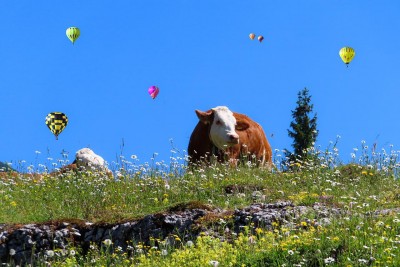Managing Heat Stress by Paul Beck

Managing Heat Stress
Paul Beck, Oklahoma State University Extension Beef Nutrition Specialist
We have had some variations in weather this spring with hot weather and intermittent stretches of cooler temperatures when storm fronts come through. The cooler temperatures are welcome, but they keep livestock from acclimatizing to hot temperatures, increasing the heat stress when hotter temperatures return.
In hot summer conditions, heat transfer failures cause accumulation of body heat resulting in heat stress, reduced performance, animal discomfort, or death. When animals experience discomfort from heat stress, their behaviors change to reduce heat load (increased water consumption, decreased feed intake, seeking shade, standing in water, etc.).
Water intake per unit of feed intake is twice as high during the summer than in the winter. Evaporation of moisture from the respiratory tract through panting is an important way for the animal to lose excess heat load. So, during heat stress water space availability becomes very important. During heat stress the linear water space increases from about 1 inch per head to 3 inches per head to allow for sufficient access to water.
Shade has been found to be beneficial to feedlot cattle, the greatest benefit of shade for finishing cattle is at the onset of the heat stress event. Cattle with shade have lower respiration rates and body temperatures when temperatures increase. Under heat stress, shaded finishing cattle in feedlots have increased average daily gain, hot carcass weights and dressing percentage as well as improved feed efficiency.
Cattle require 1.8 to 9.6 square yards per head depending on the size of the animal. Effective shade structure design depends on the thermal properties of the shade material, the ground cover under the shade, height of the structure, the amount of shade provided per animal, the level of ventilation (lower ventilation can trap heat under the structure), and the orientation of the structure. Shade structures should be at least 12 feet high to reduce direct solar radiation and increase air movement in the shelter. Metal shades effectively block direct solar radiation, but it can accumulate heat and radiate it on the animal. Shade cloth allows more air movement and heat dissipation.
Providing shade, if designed correctly, is an effective strategy to reduce heat load by reducing heat accumulation from direct solar radiation and has animal welfare benefits that can improve performance.
Dr David Lalman provides tips for producers on preventing heat stress in cattle from a classic Sun Up TV episode https://www.youtube.com/watch?v=daseqzNMAi0 from August 4, 2012.
Upcoming Events
Crops, Cows & Critters - Southwest New York Dairy, Livestock & Field Crops Newsletter Sponsorship
December 19, 2025
Our two forms of publications feature research-based and timely information from our four specialists, listed to the right, along with local event notifications and Cornell University outreach. This information is provided to participants who range from dairy, livestock, and field crops producers to agricultural suppliers and consultants.
Weekly Email Update: Shared with 625+ households who have signed up with our program.
Monthly Paper Mailer: To reach our stakeholders and farmers who lack internet access, we send out a monthly mailer where your company's logo and contact information would be featured with a mailing list of 330+ households.
If you sponsor our weekly and monthly publications you reach approximately 955 households.
Visit our website to view our newsletters!
2025 Cornell Food Beverage & Animal Feed Manufacturer Survey
December 19, 2025
Industry and Educational Advocates for New York State's Food, Beverage, and Animal Feed Manufacturing industries:
As you know, NYS has a diverse food and beverage manufacturing industry, in both the types of industries that exist and the wide distribution of firms by scale. Many manufacturing firms have strong backward linkages to agricultural production sectors in the state that support both farm-level and downstream food industry firms and consumers. In collaboration with the New York State Department of Agriculture and Markets, a team from Cornell University's Charles H. Dyson School of Applied Economics and Management has recently rolled out the 2025 New York State Food, Beverage, and Animal Feed Manufacturer Survey. The industry will benefit from an updated assessment of the industry that informs private and public investments and opportunities to support firm growth and improved profitability.
Boots in the Barn: Cornell Dairy Research Updates
January 13, 2026
January 20, 2026
January 27, 2026
February 3, 2026
February 10, 2026
February 17, 2026
February 24, 2026
Join us for some or all!
Announcements
No announcements at this time.





